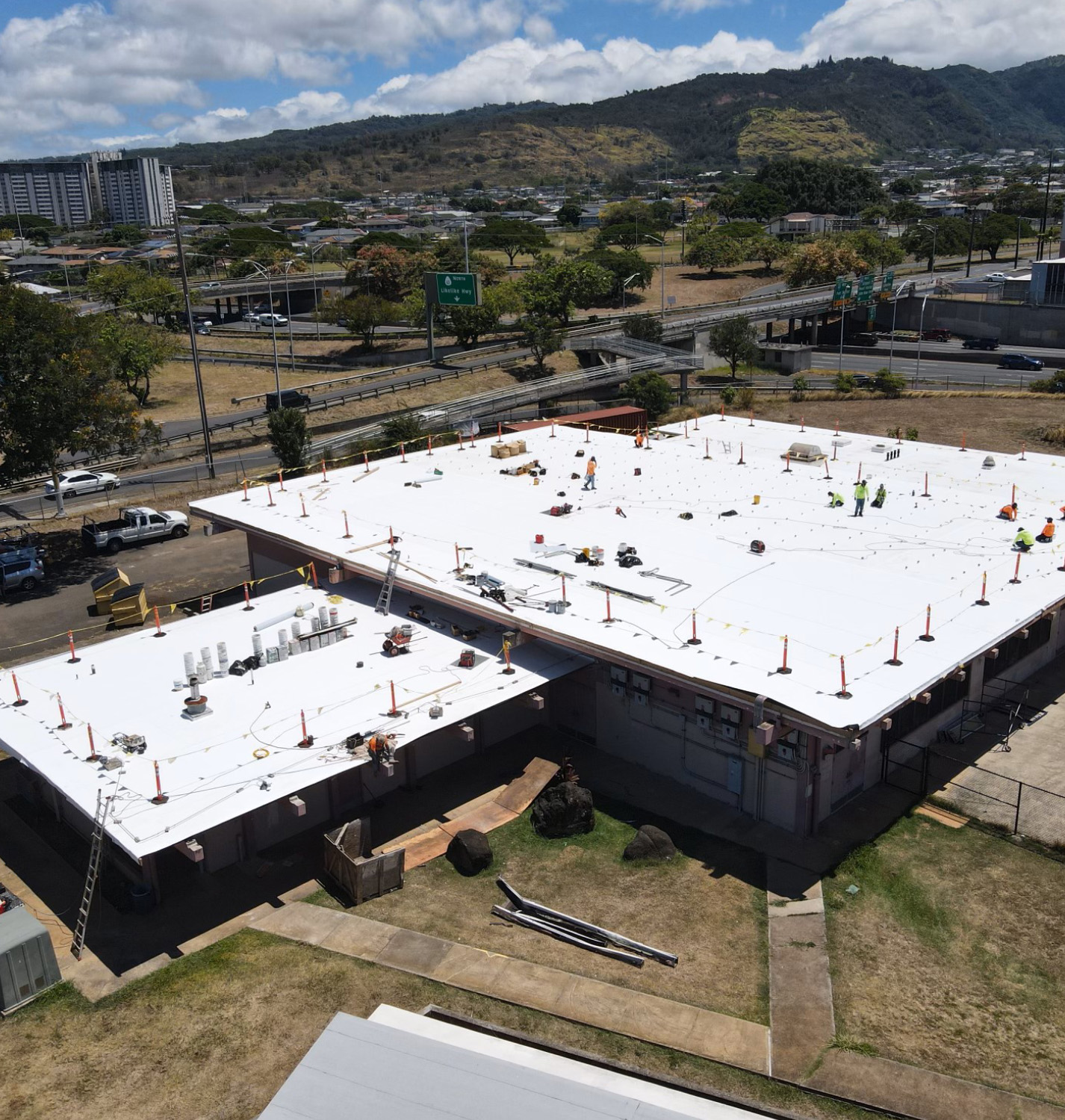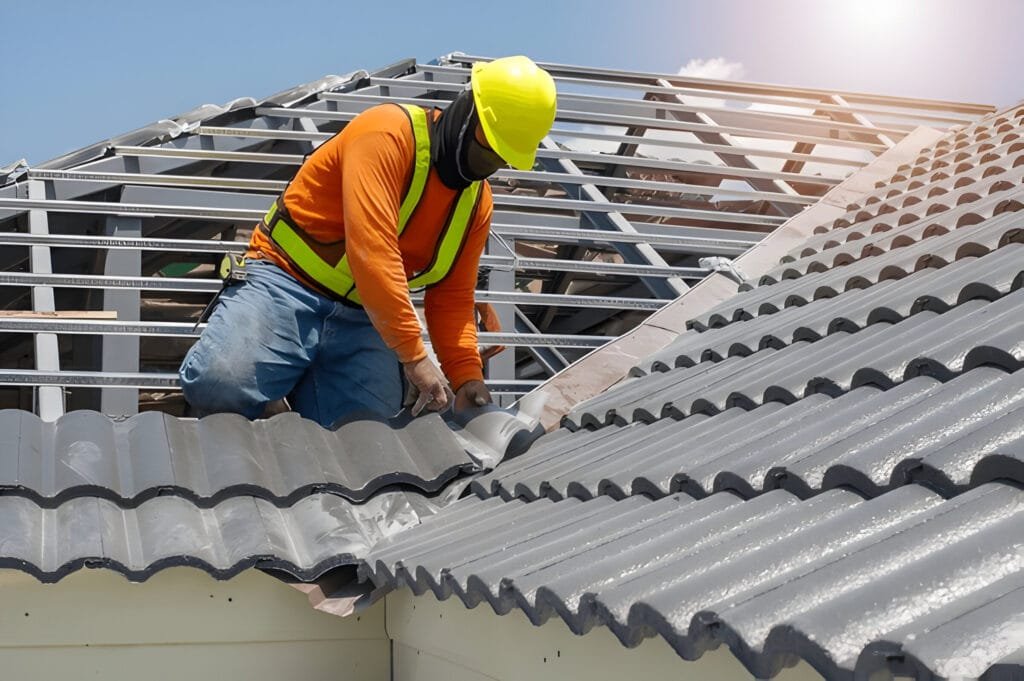Reveal Typical Roofing Troubles and How to Address Them Successfully
When it comes to your roof covering, finding troubles early can save you time and cash. You may discover water stains on your ceiling or split tiles during your regular checks. Neglecting these signs can result in bigger issues down the line. Comprehending exactly how to identify and resolve these common roof covering troubles is essential for maintaining your home's honesty. Yet what certain steps should you require to assure your roofing continues to be in top condition?
Identifying Roofing Leakages and Their Reasons

Next, analyze your roof covering from the exterior. Look for missing out on or split ceramic tiles, rusted blinking, or damaged rain gutters.
During heavy rain, observe your roof covering for any kind of merging water or drips. This can disclose leaks that may not show up during completely dry problems. By remaining vigilant and consistently checking your roofing, you can catch leaks early and protect your home from more damage.
Managing Missing Out On or Harmed Shingles
When you notice missing out on or harmed roof shingles, it's crucial to act swiftly to avoid more concerns. You'll desire to recognize the degree of the damages, repair any missing tiles, and consider preventive upkeep tips to maintain your roof in leading shape. Taking these actions can save you money and time later on.
Recognizing Tile Damage
Although tiles are created to hold up against the components, they can still endure damages with time, resulting in prospective leaks and costly repair work. To recognize roof shingles damages, start by evaluating your roofing for missing out on, cracked, or curled roof shingles. Seek signs of discoloration or granule loss, which can indicate deterioration. Focus on any locations where tiles are raising or twisting, as these can create susceptabilities. It's additionally smart to examine for water spots or mold and mildew on your ceilings and wall surfaces, as these may indicate leakages stemming from harmed shingles. Routinely checking your roof, specifically after extreme climate, can aid you capture issues early and maintain the integrity of your home.
Fixing Missing Tiles
After spotting roof shingles damage, the following step is dealing with any missing out on or damaged tiles promptly to stop further issues. Beginning by evaluating the damaged area and figuring out just how lots of roof shingles require substitute. If you can, climb onto your roof covering safely, putting on ideal gear. Get rid of any broken tiles meticulously using a crowbar. When you have actually removed the area, slide in the brand-new roof shingles, guaranteeing they line up with the existing ones. Secure them with roof nails and use roof covering adhesive for added stability. Do not neglect to secure the edges to avoid water infiltration. If you're awkward with the repair work, it's smart to call an expert. Doing something about it promptly will aid preserve your roof's stability and expand its lifespan.
Preventive Upkeep Tips
How can you keep your roof covering in top shape and prevent tiles from going missing or getting damaged? Routine examinations are crucial. Check your roofing system a minimum of twice a year and after extreme climate. Search for indicators of wear, such as curling, breaking, or loosened shingles.
Keep rain gutters tidy and devoid of debris to guarantee appropriate water circulation and prevent tile damages. Trim overhanging branches to decrease the risk of them scratching versus your roofing system throughout storms.
Think about applying a protective sealant to extend your tiles' life-span. Finally, if you observe any issues, resolve them without delay to stay clear of pricey fixings later on. Taking these safety nets can conserve you time and cash while guaranteeing your roofing system stays durable and reliable.
Recognizing Roofing System Air Flow Issues
Appropriate roof air flow is vital for keeping the durability and performance of your roofing system, as it assists regulate temperature level and dampness degrees in your attic room. Without ample air flow, you might deal with problems like excessive warm accumulation, resulting in early tile deterioration, or boosted moisture that can trigger mold development and wood rot.
To assess your roofing system air flow, check for indications of getting too hot, such as deformed roof shingles or a hot attic room. Look for blocked vents, which can restrict air movement and trap warm. You must guarantee your intake and exhaust vents are well balanced, allowing for proper air exchange.
Attending to these concerns quickly can safeguard your roofing system and save you from expensive fixings down the line. Stay proactive in keeping your roofing system's air flow to secure your home.
Dealing With Roof Moss and Algae Development
While you may appreciate the natural appearance of moss and algae on your roof, these organisms can bring about considerable troubles if left uncontrolled. They trap dampness, which can lead to shingle degeneration and leaks. To tackle this issue, begin by getting rid of any type of noticeable development. Utilize a soft-bristle brush to carefully scrub away the moss and algae, bewaring not to harm your roof shingles.
Following, consider using a specialized roofing system cleaner or a blend of water and bleach to kill staying spores. Normal inspections and maintenance will aid protect against moss and algae from returning, guaranteeing your roofing system remains in excellent form for years to come.
Repairing Tornado Damage and Wind Issues
After a storm, it's crucial to analyze your roofing for damage triggered by high winds and heavy rain. Beginning by checking for missing out on or broken roof shingles, as these are usual casualties. If you discover any, it is very important to change them without delay to stop leaks. Next, evaluate the flashing around smokeshafts and vents; harmed flashing can bring about water penetration.
Try to find any type of drooping locations, which could indicate water build-up or structural issues. If you locate any type of particles, like branches or leaves, remove them meticulously to avoid more damage. If your rain gutters are clogged, clear them to assure proper water drainage.

For small repairs, you could manage it yourself, however don't wait to call a specialist for substantial damages. Remember, acting promptly can conserve you from bigger troubles down the line, so take that assessment seriously and resolve any type of issues asap.
Acknowledging Signs of Architectural Damages
How can you inform if your roof covering is experiencing from architectural damage? Next off, check for splits or gaps in the wall surfaces or ceiling, as these can signal changing or settling due to roof covering problems. If you discover missing or broken tiles, it's vital to resolve them quickly, as they can subject your roofing system to more damage.
Regular Maintenance Tips for Long Life

Routine Evaluations Value
Given that a roof is your home's initial line of protection against the components, normal inspections are vital for keeping its stability. You should inspect your roofing at least two times a year, ideally in springtime and loss, to catch potential concerns early. Maintaining up with these inspections can stop expensive fixings down the line and extend your roof's life-span, ensuring your home remains safe and audio for years to come.
Appropriate Seamless Gutter Maintenance
Normal roofing assessments naturally lead to the relevance of proper gutter upkeep. Check your seamless gutters for leaks or corrosion; they can trigger water damage to your roof covering and home. By complying with these suggestions, you'll extend your gutters' lifespan and secure your roofing.
Frequently Asked Questions
Exactly How Can I Select the Right Roof Product for My Home?
To choose the appropriate roof product for your home, consider climate, toughness, and looks. Research options like asphalt roof shingles, steel, or ceramic tile. Consider upkeep needs and budget plan to locate what fits you ideal.
What Are the Signs I Required a Roof Replacement Rather of Repair?
If you observe widespread leakages, drooping, or missing out on shingles, you could need a roof replacement. Additionally, if your roof covering's nearing its lifespan or has considerable damage, roofing contractors oahu it's time to contemplate a full replacement rather than simply repairs.
Exactly how Often Should I Set Up Specialist Roof Evaluations?
You should set up professional roofing system inspections at least once a year, ideally in springtime or fall. This aids capture prospective concerns early, guaranteeing your roofing stays in great problem and lengthening its lifespan.
Can I Set Up a New Roof Over My Old One?
You can install a brand-new roofing over your old one, but it's necessary to inspect local building regulations and guarantee the existing roof's problem is audio. This strategy can conserve money and time, but think about prospective problems.
What Is the Typical Lifespan of Different Roof Covering Products?
The standard life-span differs by material: asphalt roof shingles last 15-30 years, metal roof coverings can last 40-70 years, while tile or slate roofs may surpass 50 years. Choose wisely based on your climate and spending plan.
Conclusion
By staying attentive and attending to typical roofing issues immediately, you can shield your home and expand your roofing's life expectancy. Regularly check for leaks, harmed shingles, and ventilation concerns, and deal with moss or algae development prior to it gets worse - roofing contractors oahu. After tornados, look for any kind of damages and make essential repair services. With a little routine maintenance, you'll not only protect your investment yet also delight in comfort understanding your roof covering remains in leading form. Don't wait-- act now!